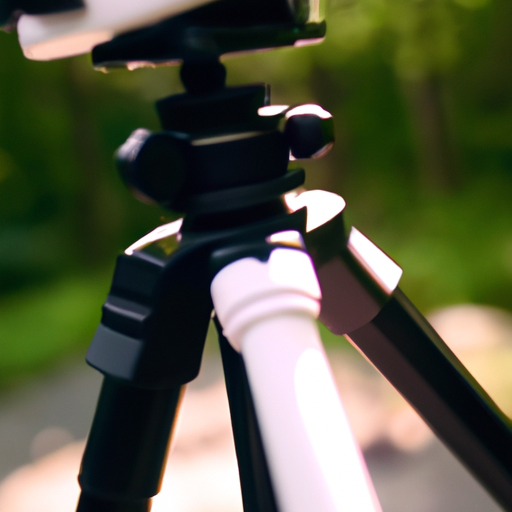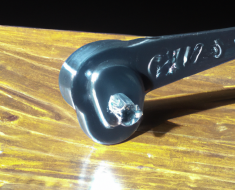“Steady aim, precise shots – find your perfect bipod for stability and accuracy.”
Benefits of Using a Bipod for Stability and Accuracy
When it comes to shooting accuracy, stability is key. Whether you are a hunter, sports shooter, or law enforcement officer, having a stable platform to shoot from can make all the difference in hitting your target. This is where a bipod comes in handy. A bipod is a device that attaches to the front of your rifle or gun, providing stability and support while shooting.
One of the main benefits of using a bipod is increased stability. When shooting from a prone position, a bipod allows you to stabilize your weapon by providing a solid base for it to rest on. This reduces muzzle jump and recoil, resulting in more accurate shots. By eliminating movement and shaking, a bipod helps you maintain a steady aim and hit your target with precision.
In addition to stability, a bipod also helps improve accuracy. By keeping your rifle or gun steady and level, you can better control your shot placement and ensure that your bullets land exactly where you want them to. This is especially important for long-range shooting, where even the slightest movement can cause you to miss your target. With a bipod, you can confidently take aim and make accurate shots time after time.
Another benefit of using a bipod is that it helps reduce fatigue. Holding a heavy rifle or gun for extended periods can be tiring and lead to shaky hands and inconsistent shooting. By using a bipod, you can take some of the weight off your arms and shoulders, allowing you to focus on aiming and firing without straining yourself. This can help improve your overall shooting performance and endurance, making it easier to stay on target for longer periods of time.
When choosing a bipod for stability and accuracy, there are several factors to consider. The first is height adjustability. A good bipod should allow you to easily adjust the height to suit your shooting position and terrain. This ensures that you can maintain proper eye alignment with your scope or sights and achieve optimal shooting posture.
Another important factor to consider is the material and construction of the bipod. Look for a bipod made from durable materials like aluminum or carbon fiber that can withstand rough handling and harsh weather conditions. A sturdy construction will provide reliable support for your rifle or gun and help ensure consistent performance shot after shot.
Additionally, consider the attachment method of the bipod. Some models come with quick-detach mounts that allow you to easily attach and remove the bipod from your weapon without tools. This can be convenient for shooters who need to switch between different rifles or guns quickly.
In conclusion, using a bipod for stability and accuracy offers numerous benefits for shooters of all skill levels. By providing a stable platform for your rifle or gun, a bipod helps improve shooting performance by reducing recoil, increasing accuracy, and minimizing fatigue. When selecting a bipod, consider factors like height adjustability, material construction, and attachment method to find the right one for your needs. With the right bipod by your side, you can enhance your shooting experience and take your marksmanship skills to the next level.
How to Choose the Right Bipod for Your Firearm
When it comes to shooting accurately and with stability, having the right equipment can make all the difference. One important accessory that can greatly improve your shooting experience is a bipod. A bipod is a two-legged support system that attaches to the front of your firearm, providing a stable platform for shooting. With so many options on the market, finding the right bipod for your firearm can be a daunting task. In this article, we will discuss how to choose the right bipod for your firearm.
The first thing to consider when choosing a bipod is the type of firearm you will be using it with. Different firearms require different types of bipods in order to achieve optimal stability and accuracy. For example, if you are using a hunting rifle, you may want a lightweight bipod that is easy to carry around in the field. On the other hand, if you are using a heavy-duty sniper rifle, you may want a more durable and heavy-duty bipod that can withstand the recoil of larger calibers.
Another important factor to consider when choosing a bipod is the height and adjustability. You want to make sure that the bipod you choose is compatible with your shooting style and preferences. Some bipods offer adjustable legs that allow you to change the height of the bipod to suit your shooting position. This can be especially useful when shooting on uneven terrain or from different shooting positions.
In addition to height and adjustability, it is also important to consider the material and construction of the bipod. Bipods come in a variety of materials such as aluminum, carbon fiber, and steel. Each material has its own advantages and disadvantages. Aluminum bipods are lightweight and durable, making them ideal for hunting rifles. Carbon fiber bipods are even lighter than aluminum and offer excellent vibration dampening properties. Steel bipods are heavier but offer superior durability and stability.
When choosing a bipod, it is also important to consider the mounting system. Most bipods attach to your firearm using a Picatinny rail or swivel stud mount. The type of mounting system you choose will depend on the type of firearm you are using and your personal preferences. Picatinny rail mounts are popular because they offer quick and easy attachment and removal of the bipod. Swivel stud mounts are more traditional and offer a secure attachment but may require additional tools for installation.
Lastly, it is important to consider your budget when choosing a bipod. Bipods come in a wide range of prices, from budget-friendly options to high-end models with advanced features. It is important to find a balance between quality and affordability when choosing a bipod for your firearm.
In conclusion, finding the right bipod for your firearm is essential for achieving stability and accuracy while shooting. Consider factors such as the type of firearm you will be using, height and adjustability, material and construction, mounting system, and budget when choosing a bipod. With the right bipod, you can greatly improve your shooting experience and take your accuracy to the next level.
Top Brands and Models of Bipods for Precision Shooting

When it comes to precision shooting, having a stable platform is crucial for achieving accuracy. One of the best ways to ensure stability while shooting is by using a bipod. A bipod is a two-legged support system that attaches to the front of your rifle, providing a solid base for your firearm. With so many brands and models of bipods on the market, it can be overwhelming to choose the right one for your needs. In this article, we will discuss some of the top brands and models of bipods available to help you make an informed decision.
One of the most popular brands of bipods is Harris Engineering. Harris bipods are known for their durability, reliability, and ease of use. They offer a wide range of models to suit different shooting styles and preferences. The Harris S-BRM Bipod is a favorite among precision shooters for its adjustable height and swivel capabilities, allowing for easy target acquisition and tracking. Another popular model from Harris is the LM Series Bipod, which features extendable legs and a sturdy construction that can withstand heavy recoil.
Another top brand in the world of bipods is Atlas Bipods. Atlas bipods are widely regarded as some of the best in terms of quality and performance. The Atlas BT10 Bipod is a favorite among long-range shooters for its versatility and stability. It features adjustable legs with five different positions, allowing you to customize the height to suit your shooting environment. The BT10 also has a built-in cant adjustment, which helps you level your rifle on uneven terrain.
For shooters looking for a budget-friendly option without sacrificing quality, Caldwell bipods are a great choice. Caldwell bipods offer excellent value for money without compromising on performance. The Caldwell XLA Bipod is a popular choice among casual shooters and hunters for its lightweight design and quick-deploy legs. It is easy to attach to your rifle and provides a stable shooting platform at an affordable price point.
If you are in need of a heavy-duty bipod that can handle the toughest conditions, look no further than the Accu-Tac Bipods. Accu-Tac bipods are built to last and are designed to withstand harsh environments without compromising on stability or accuracy. The Accu-Tac BR-4 G2 Bipod is a favorite among tactical shooters for its rugged construction and precision engineering. It features independently adjustable legs with multiple height settings, allowing you to adapt to different shooting positions quickly.
In conclusion, finding the right bipod for stability and accuracy is essential for precision shooting. With so many top brands and models of bipods available, it can be challenging to choose the best one for your needs. Whether you prefer Harris Engineering, Atlas Bipods, Caldwell, or Accu-Tac, there is a bipod out there that will meet your requirements. Consider factors such as adjustability, durability, weight, and price when selecting a bipod for your rifle. Remember that investing in a high-quality bipod will improve your shooting performance and help you achieve better accuracy on the range or in the field.
Tips for Properly Mounting and Adjusting a Bipod
If you’re looking to improve your shooting accuracy and stability, using a bipod can be a game-changer. A bipod is a simple yet effective tool that attaches to the front of your rifle, providing a stable platform for shooting. However, finding the right bipod and properly mounting and adjusting it are crucial steps to ensure optimal performance. Here are some tips to help you choose the right bipod and set it up correctly.
When choosing a bipod, there are several factors to consider. First and foremost, you’ll want to make sure that the bipod is compatible with your rifle. Most bipods come with different mounting options, such as Picatinny rails or swivel studs, so be sure to check that the bipod you choose will fit your rifle.
Next, consider the height and adjustability of the bipod. A bipod with adjustable legs will allow you to fine-tune the height and angle of your rifle, which can be especially helpful when shooting on uneven terrain. Additionally, look for a bipod with rubber feet or spikes for added stability on various surfaces.
Once you’ve selected the right bipod for your needs, it’s time to mount and adjust it properly. Start by attaching the bipod to your rifle according to the manufacturer’s instructions. Make sure the bipod is securely attached and that there is no wobble or play in the connection.
Next, adjust the height of the bipod to suit your shooting position. Ideally, the rifle should be level when resting on the bipod, with the legs extended just enough to provide stability without being too high. Experiment with different heights and angles until you find the most comfortable and stable position for shooting.
When setting up your bipod, pay attention to the terrain and shooting conditions. If you’re shooting on uneven ground or at a steep angle, you may need to adjust one leg of the bipod shorter than the other to keep the rifle level. Additionally, consider using a sling or sandbag for added support and stability.
Finally, practice using your bipod regularly to become familiar with its capabilities and limitations. Experiment with different shooting positions and distances to see how the bipod affects your accuracy and stability. Remember that proper technique, such as breathing control and trigger squeeze, is just as important as having a good bipod.
In conclusion, finding the right bipod for stability and accuracy is essential for improving your shooting skills. By choosing a bipod that fits your rifle and adjusting it properly, you can enhance your shooting experience and achieve better results on the range or in the field. Remember to practice regularly and experiment with different setups to find what works best for you. With patience and dedication, you’ll soon be enjoying improved accuracy and stability with your new bipod.
Comparison of Bipods vs Other Stability Aids for Shooting
When it comes to shooting accurately, stability is key. Whether you’re a seasoned marksman or just starting out, having the right equipment can make all the difference in hitting your target. One popular tool for achieving stability while shooting is a bipod. But how does a bipod stack up against other stability aids? Let’s take a closer look at the comparison of bipods vs other stability aids for shooting.
First, let’s talk about bipods. Bipods are typically attached to the front of a rifle and provide a stable platform for shooting. They come in various sizes and styles, with adjustable legs that allow you to customize the height and angle of your shot. Bipods are popular among long-range shooters and hunters because they offer a solid base for taking precise shots at distance.
On the other hand, shooting sticks are another common stability aid used by shooters. Shooting sticks consist of two or three legs that can be adjusted to different heights to support the rifle while shooting. They are lightweight and portable, making them a popular choice for hunters who need to move quickly and quietly through the woods.
While both bipods and shooting sticks provide stability while shooting, there are some key differences between the two. Bipods offer more adjustability in terms of height and angle, allowing for greater precision when taking shots. They also tend to be more durable and stable than shooting sticks, which can wobble or shift under heavy recoil.
Another stability aid commonly used by shooters is sandbags. Sandbags provide a solid base for resting the rifle while shooting, helping to absorb recoil and reduce muzzle jump. While sandbags are inexpensive and easy to use, they can be bulky and cumbersome to carry around, making them less practical for hunters on the move.
In comparison to bipods, sandbags lack the adjustability and versatility that bipods offer. Sandbags also require a flat surface to rest on, which may not always be available in field conditions. However, sandbags can be a cost-effective option for shooters looking to improve their stability without investing in a more specialized piece of equipment.
Ultimately, the right stability aid for you will depend on your shooting style and preferences. If you value precision and adjustability, a bipod may be the best choice for you. On the other hand, if you prioritize portability and simplicity, shooting sticks or sandbags may be more suitable options.
In conclusion, bipods offer a stable and adjustable platform for shooting that can help improve accuracy and consistency. While other stability aids such as shooting sticks and sandbags have their own advantages, bipods stand out as a versatile and reliable option for shooters looking to take their marksmanship to the next level. Consider your needs and preferences when choosing a stability aid for shooting, and remember that practice makes perfect when it comes to achieving accuracy on the range.




